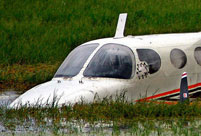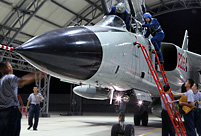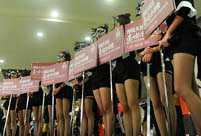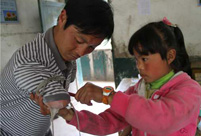I. The Development and Progress in Tibet Is the Inevitable Result of History
The development and progress in modern Tibet results from the innate logic of its social and historical environment, and has its roots in China' s progress in a larger context. Its development is in line with the advance of world' s modern civilization. Prior to 1959, Tibet was a typical society of feudal serfdom under a theocracy, characterized by a combination of political and religious powers. The development and progress in Tibet began right from the ruins of feudal serfdom.
Tibetan society prior to 1959
There is plenty of literature describing the situation of Tibetan society before 1959. From the following excerpts one can have a glimpse at the darkness and backwardness of old Tibet.
In his 1905 book The Unveiling of Lhasa, former British journalist in India Edmund Candler, who worked for the Daily Mail, recorded the details of the old Tibetan society:
Old Tibet "is governed on the feudal system. The monks are the overlords, the peasantry their serfs." "...at present, the people are medieval, not only in their system of government and their religion, their inquisition, their witchcraft, their incarnations, their ordeals by fire and boiling oil, but in every aspect of their daily life." "... he toils a lifetime to win by his own labour and in scanty measure the necessaries ..." Lhasa was "squalid and filthy beyond description, undrained and unpaved. Not a single house looked clean or cared for. The streets after rain are nothing but pools of stagnant water frequented by pigs and dogs searching for refuse."
In Portrait of A Dalai Lama: The Life and Times of the Great Thirteenth, a 1940s work by Charles Bell, the British Tibetologist made observations of the harsh punishments in Tibet: "At the same time the Tibetan criminal code is drastic. In addition to fines and imprisonment, floggings are frequent, not only of people after they have been convicted of an offence, but also of accused persons, and indeed witnesses, during the course of the trial. For serious offences, use is made of the pillory as well as of the cangue, which latter is a heavy square wooden board round the neck. Iron fetters are fastened on the legs of murderers and inveterate burglars. For every serious or repeated offences, such as murder, violent robbery, repeated thefts, or serious forgery, the hand may be cut off at the wrist, the nose sliced off, or even the eyes gouged out, the last more likely for some heinous political crime. In former days those convicted of murder were put into a leather sack, which was sewn up and thrown into a river."
【11】 【12】 【13】 【14】 【15】 【16】 【17】 【18】 【19】 【20】
【21】 【22】 【23】


 No news of survivors in Lao Airlines crash
No news of survivors in Lao Airlines crash Five fighters in flight training
Five fighters in flight training London mayor hails free trade, subway system on China tour
London mayor hails free trade, subway system on China tour Different eye catching shows at housing fairs in China
Different eye catching shows at housing fairs in China Chalk it up to great courage
Chalk it up to great courage Tibetan girl helps mobilize volunteers onlin
Tibetan girl helps mobilize volunteers onlin Lingerie show dazzles Wuhan Motor Show 2013
Lingerie show dazzles Wuhan Motor Show 2013  Chinese screen goddesses from Beijing Film Academy
Chinese screen goddesses from Beijing Film Academy  Weekly Sports Photos
Weekly Sports Photos Bayi Parachute Team of PLA Air Force
Bayi Parachute Team of PLA Air Force World has never been dark-- a blind kid’s life in Tibet
World has never been dark-- a blind kid’s life in Tibet Change to law may make it easier to sue polluters
Change to law may make it easier to sue polluters UNESCO world heritage site: Montale Tower
UNESCO world heritage site: Montale Tower U.S. Senate leader announces bipartisan deal
U.S. Senate leader announces bipartisan deal Fiber-optic wedding dress show shinning in Suzhou
Fiber-optic wedding dress show shinning in Suzhou Day|Week|Month